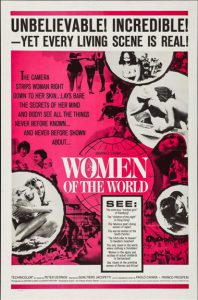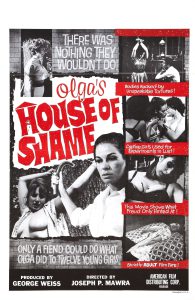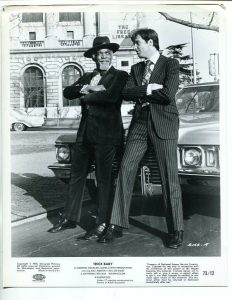Andy Warhol's Bad (1977) by #JedJohnson
w/#CarrollBaker #SusanTyrrell #PerryKing #LawrenceTierney
A Queens housewife does home electrolysis and sends sleazy hit women on repulsive errands.
"Art Was Never Like This."#RatedX#NotQuiteClassicCinema pic.twitter.com/NUnyEtfHkS
— Angus Kohm (@AngusKohm) August 7, 2021
Andy Warhol’s Bad (1977) is one of those films that is almost mythical to me (in terms of my own life and how I experienced it – not that I had heard great mythical stories about it). I stumbled onto it as a VHS rental decades ago. I had been exploring Andy Warhol’s filmography, starting with Flesh for Frankenstein (1973) and Blood for Dracula (1974), of course. The VHS tapes showed up at my local video store and looked like something special. The boxes actually said Andy Warhol presents Dracula, and Andy Warhol presents Frankenstein. I read them as Andy Warhol’s Dracula and Andy Warhol’s Frankenstein, which I swear some boxes actually said.
One of the first things that I discovered about these films, is that they were not directed by Andy Warhol. Some guy named Paul Morrissey seemed to be getting all of the credit. How can this be? How can a film be called Andy Warhol’s (whatever) and not be directed by Andy Warhol? This was a new concept to me…
I’m not sure what I really knew about Andy Warhol in those days. Not a lot, I’m sure. I knew he was an artist. A “pop artist”, in fact, who painted things like soup cans. And that he had famously predicted that “In the future, everyone will be world-famous for 15 minutes.” Although, it turns out that he may not have ever said that, in fact. Go figure.
 At some point I must have found out that Andy Warhol made movies. Was that before the VHS tapes of …Dracula and …Frankenstein turned up at my store? I’m not sure. But after I watched those movies, and found them to be suitably unique. and interesting, I decided to rent all of the Andy Warhol’s (whatever) movies. There was Flesh (1968), Trash (1970), Heat (1972) and last, but not least, Bad (1977). The VHS tapes all looked like they were from a matching set, and it seemed like Andy Warhol had a thing for one word titles that were somewhat provocative. And most of them starred a guy named Joe Dallesandro, who was presented as if he was a big star, but I had never heard of him. It turned out that he was what they call a Warhol superstar. He went on to have a decent acting career, at first in Europe and then back in North America, where he appeared on TV shows like Miami Vice (1984-90) and The Hitchhiker (1983-91). He was also in John Waters’ Cry-Baby (1990), which is interesting for other reasons that will become apparent.
At some point I must have found out that Andy Warhol made movies. Was that before the VHS tapes of …Dracula and …Frankenstein turned up at my store? I’m not sure. But after I watched those movies, and found them to be suitably unique. and interesting, I decided to rent all of the Andy Warhol’s (whatever) movies. There was Flesh (1968), Trash (1970), Heat (1972) and last, but not least, Bad (1977). The VHS tapes all looked like they were from a matching set, and it seemed like Andy Warhol had a thing for one word titles that were somewhat provocative. And most of them starred a guy named Joe Dallesandro, who was presented as if he was a big star, but I had never heard of him. It turned out that he was what they call a Warhol superstar. He went on to have a decent acting career, at first in Europe and then back in North America, where he appeared on TV shows like Miami Vice (1984-90) and The Hitchhiker (1983-91). He was also in John Waters’ Cry-Baby (1990), which is interesting for other reasons that will become apparent.
Andy Warhol’s Bad was the last of the first wave of Andy Warhol films that I made of point of renting and watching, and it was by far my favourite. I would say that it was the best, but that’s a highly subjective thing, and I don’t want to offend anyone who has another favourite (but it was the best). I would say that it blew my mind. It was so edgy and shocking (to me) and like the review on the cover of the VHS box said, it’s “A picture with something to offend absolutely everybody.” — New York Post
Needless to say, I loved it, and I wanted to buy a copy and add it to my collection. Unfortunately, it was pretty hard to come by. The VHS tape that I had rented was technically for sale, as all tapes were at my favourite video store, but the price on the sticker was $199.99. In my experience, this basically meant that the store did not want to sell it, but if anyone was crazy enough to pay two hundred dollars for it, they’d take it. I may have been crazy, but I wasn’t that crazy.
So, I spent the next twenty years keeping my eyes peeled, and scouring bargain bins everywhere that In went. But this movie was never for sale anywhere. I might have considered giving up and paying two hundred dollars for it, but it had long since disappeared from that store. Had someone else been crazy enough to pay that price? I’ll never know.
A couple of years ago, I found a cheapjack DVD released by Cheezy Movies. It was probably no better a print that I had originally seen on that old VHS tape many years ago, but the price was right, so I bought it. Why has this film never been given the super-deluxe collector’s edition treatment? Why is there no Blu-ray? I’m sure there’s some bizarre legal reasons, or something like that. In any case, i’ll take what I can get until something better comes along.
It was great to finally see the movie again. Of course, it’s not quite so edgy and offensive anymore (to me). I’ve watched a lot of edgy, crazy, offensive movies in the decades since I first saw Bad.
This brings to mind another interesting point. many people have compared Bad to the films of John Waters. Some have even suggested that it was Andy Warhol’s attempt to do a John Waters film (that could have been a good title, actually: Andy Warhol’s John Waters). This is not something that would have ever occurred to me back when I first saw Bad, because I don’t think I had ever seen a John Waters film. Watching it now, after becoming a full fledged fan of John Waters and collecting all of his movies, I can see the comparison. There are still a lot of differences, and I’m not sure that it was actually an attempt to “do” John Waters. But I like Bad for many of the same reasons that I like John Waters, so that’s something, I guess.
I recently found out that Andy Warhol’s Bad (1977) ran for many years as a midnight movie in Chicago. This gives it the ultimate seal of approval as a perfect selection for a #FridayNightAtTheHomeDriveIn. It’s a wonderful, nostalgic blast from the past, and a timeless piece of #NotQuiteClassicCinema. And if you’re a little on the new side, it might still have the power to shock and offend you. And what could be better than that?










